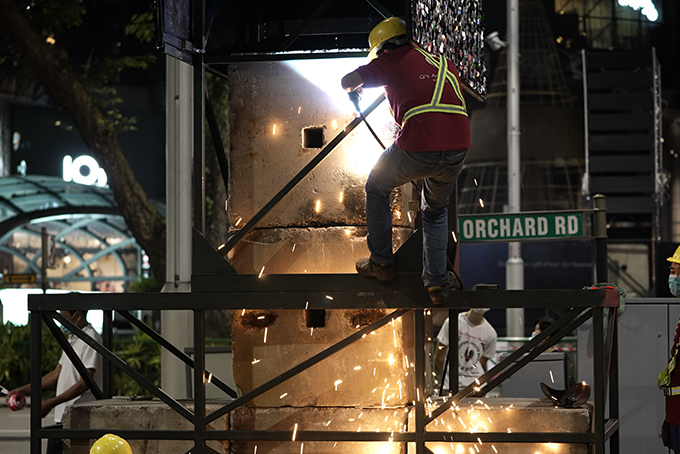Film-maker Boo Junfeng on the spark behind the short film he created for Vogue Singapore
20 November 2020
Vogue Singapore collaborates with celebrated local director Boo Junfeng to create a poignant and lilting cinematic response to ‘Spark,’ the theme of our publication’s second issue
One of Singapore’s most prominent film-makers, Boo Junfeng has a stellar slate of movies to his name. Boo has lent his considerable cinematic weight to events like Pink Dot and the 2018 National Day Parade. His passion is palpable, coming off the silver screen in waves, and the world has taken notice. He doesn’t balk at the prospect of tackling trickier themes, either. Pervading his work are hot button topics like national identity (in his debut feature Sandcastle), the death penalty (2016’s Apprentice, which was nominated to be Singapore’s entry to the Academy Awards that year), and homophobia (Tanjong Rhu, based on true and devastating events in the 1990s).
Naturally, it is this fiercely independent creative streak of Boo’s that Vogue Singapore most admires. So we asked him to create a short film centered around the theme of our magazine’s second issue, ‘Spark,’ but otherwise granted Boo free reign to capture whatever he wanted. He collaborated with the non-profit Transient Workers Count Too (TWC2), which promotes equitable treatment for migrant workers in Singapore, in order to learn more about what’s happened since the national spotlight surrounding their rights faded over the summer. Looking to create an observational piece rather than an outright campaign video, he eventually landed upon a story that beautifully captures Singapore’s unique holiday spirit and the reality behind what it truly takes to deck the halls.

Tell us more about the starting point for the conception of your short film.
Personally, when I think of a spark, I think of an idea, I think of connection. Seeing something lit up only for an instant, and perhaps trying to capture it in that moment. The image of a welder’s spark came to mind. It’s always been an image that was quite arresting to me. It’s really pretty to look at, with the light dissipating, but then you forget how hard and hazardous the work actually is. In the glow of the light, you forget the heat.
At that time, I had also been going up and down Orchard Road, seeing the decorations start to go up. It was like every day you got there, suddenly a new stretch was done. So you wonder what happened overnight. I started to ask around. I began working with some migrant worker advocacy groups. Then Orchard Road got back to me to say, “We’re going to put up the main arch this weekend.” And I was given access over three nights to film the construction. I was pleased to hear that there would be welding—there was my literal spark.
Does this project have any overlap with your earlier filmography? Thematically or narratively, perhaps?
Actually, as I was working on this piece, I did think of my second short film [Stranger – 过客]. It was sort of an independent documentary essay that I made way back in 2004. It was about me, as a young Chinese person—Singapore’s racial majority—walking through Little India during the Deepavali celebrations. The lights were up, music, everything. I thought of this new film as a bit of a companion to that. Because in [Stranger – 过客] I also talked about my thoughts at that time, feeling like a stranger in my own country, because I was suddenly a minority in that place.

What was the actual filming like? What’s your artistic process for an unscripted project like this?
Construction started at 11:59pm every night, and ended at 4am. We camped out overnight with the workers over those three nights, to observe and film them. We watched their faces and their process. With documentary films—which I rarely make—you kind of have a rough idea of what kind of shots you want to pick up, but you don’t really have the story in mind until you’ve shot it. As someone who is used to planning his projects, it was quite unsettling at first. As the nights went on, the message began to slowly crystallise in my head, but it was never written down on paper.
And what was that message, in the end?
Seeing the rest of the economy begin to open up, people are starting their Christmas shopping. I knew that this film was going to be for the December issue of Vogue. It was important to me that we don’t forget, in this time of giving, that the people who have built our homes and offices and roads still remain stuck, for the most part, in the dormitories. The message was that we should be thinking of them and continuing to help them wherever we can. During the circuit breaker, when the infection numbers were really high, there was a lot of national attention on them. But now, just because the numbers have gone down doesn’t mean we should stop paying attention to their experiences.
I found out from TWC2 that it is going to be International Migrants’ Day on December 18th. They ‘deck the halls’ for us—that’s the music playing over the footage. So it’s a very simple message in that sense. That they’re the invisible crew of people that has kept this city going, and they should be acknowledged for their work.
“They’re the invisible crew of people that has kept this city going, and they should be acknowledged for their work”
How much attention has the subject of migrant labour gotten in Singaporean cinema?
There have been a few films made about it in Singapore. One of them was called A Yellow Bird. There’s another film called A Land Imagined, which looked at migrant construction workers in Singapore. There was also a documentary made last year called I Dream of Singapore. The director of that film [Lei Yuan Bin] was actually my cinematographer on this video. Yuan Bin was actually the one who connected me to TWC2 and the workers they advocate for.
Speaking of your collaborators on this shoot, who else made up your team?
It was a really bare-bones team. I didn’t even have a sound person on set. Yuan Bin is incredibly intuitive with the camera; I feel like when I work with him, I get to be more open. I can trust him to capture something unexpected. I used the shoot as an opportunity to explore a different kind of collaborative process. It’s a kind of film-making I’d like to bring to my narrative work, in the future.

What was it like for the workers, for a film crew to be there?
Their crew was a lot larger, obviously, large enough to be able to put it all together relatively easily. You could see that the men were all working really hard, while everyone else was sleeping. You’re looking around you, and Orchard Road is dead. Empty. But then—there are these workers, toiling into the night and making it happen.
Initially, you could tell that they were shy about being filmed. When we pointed a camera at them, they would kind of inch away at first. That happened mostly on the first night. They got more comfortable with us being around, filming them constantly, after that. We were also trying our hardest not to get in the way!
What’s next for you, as a film-maker?
I’ve been writing my third feature film for a couple of years now. Production was supposed to start early next year, but it’ll be moved to the end of next year now because it’s shooting in Taiwan. I’ve been lucky that I had set aside this year as a ‘writing year,’ so the pandemic didn’t impact me as much as a writer-director. I had that flexibility of going into development rather than production work for a few months.
But there are lots of Singaporean [film] crew members who haven’t been as fortunate. The Singaporean Association of Motion Picture Professionals started to rally the community together to help those who have been more in need.
I’m also on the board of the Singapore International Film Festival, so on the release and distribution side, we’ve been working on a way to make the festival happen this year. Really, it’s been a year of curveballs. I guess it’s all about trying to navigate it, and do more than survive.
Visit TWC2 for more information on migrant workers in Singapore or to make a donation.




